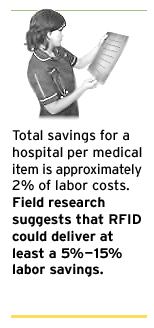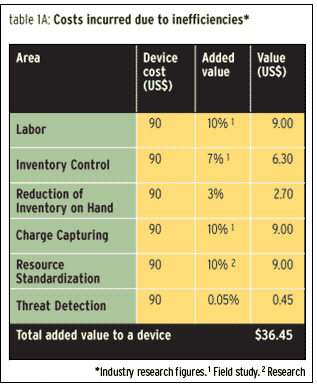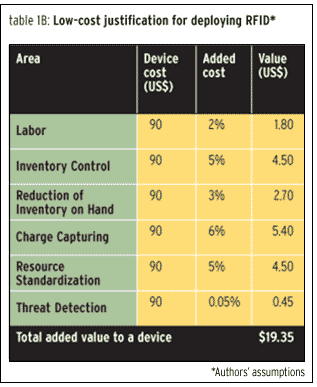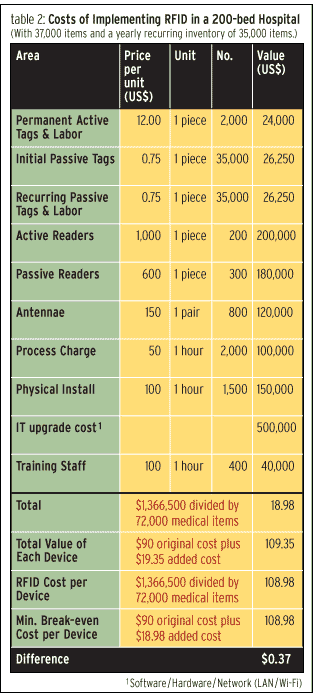Oct 18, 2004Part 1 of this special report on the use of RFID in the healthcare industry explained the Micro-Modular approach to using RFID in healthcare. In Part 2, the authors detail the processes involved in the Micro-Modular approach and how they can create benefits for healthcare providers.
The Flow of Micro-Modular Information
The four-wall micro-modular RFID implementation establishes an item-based structure. The location of any item will be stored along with its “vertical industry standard PML (physical markup language) in the EPC Information Services (EPC IS), network-based applications built on the EPCglobal Network. Because different departments need the item, the item’s location and sterilization history, and the various tasks the item can perform in different procedures, will be maximized through the
procedure-based rules engine (logic for reporting and analysis of data). The hospital’s enterprise applications healthcare compliance manager will schedule each device by performing time and location audits on those devices according to the needs of the hospital, department and procedure. The manager will audit the completed schedule tasks by querying both the EPS-IS for location and the “rules engine” for the availability of the device. An example of this concept is found in Figure 3 above: By following the red dotted line, one can see the true utility (added value) that the device D1 used in the OR Department gains by its reuse through proper scheduling in the Emergency Room department in procedure P2.
The Micro-Modular approach solves the following challenges: supply chain execution; supply chain optimization; supply chain process management; compliance; charge capturing; reimbursement; data integration; and workflow.
Direct Benefits in the Operating Room
Our field and industry research have found these figures are well within the parameters of acceptability.
RFID implementation in a closed-loop healthcare facility will produce the following tangible benefits:
|
In a November 2001 Healthcare Financial Management Association (HFMA) audio teleconference (“Supply Chain Management for the CFO,” presented by Jamie Kowalski) of 321 executives stated that the total supply chain represents 35 percent to 45 percent of their hospitals total expenses. In that same teleconference, supplies and medical instruments represented 25 percent of the total hospital expense.
Labor
Costs incurred per device due to lack of efficiencies in labor are 2 percent to 15 percent per device (see attachments). To reduce these costs one would be required to have:
- Increased labor efficiencies
- Defined workflow
- Automation of manual actions
- Improved sequence counts
- Resource utilization
By deploying RFID in the OR, one can easily keep track of all the surgical equipment needed for any procedure and speed up the process by increasing the efficiency of surgical setup and cleanup. These efficiency gains can only be achieved at the Micro device level of each procedure.
Inventory Control
Costs incurred per device due to lack of efficiencies in inventory control are on an average of 5 to 10 percent. To reduce these costs, one would like to keep track of the following:
- Inventory loss and theft of supplies
- Elimination of expired items (see 7)
- Scheduled maintenance for medical devices (see 8)
- How supplies are used—first in, first out (FIFO) or last in, first out (LIFO)
- The percentages of disposable supply costs that are not recovered
- Stock-shortage alerts
RFID can be deployed to track and trace inventory that will almost totally eliminate inventory loss.
|
Bradley H. Sokol has started three emerging technology companies in a variety of industries. In 1999, he launched Electronic Directory Corp., an interactive, public-access, touch screen mapping directory for hospitals, tourism and commercial building developments. He has consulted in a variety of fields including healthcare coding for medical devices. He can be contacted by sending e-mail to livepress@aol.com. Sapan Shah is a project leader for RFID at Patni Computer Systems, an India-based systems integrator. Patni’s dedicated RFID practice offers a complete range of RFID services as part of its enterprise application solutions. Sapan is actively involved with the developments of RFID within and outside Patni and regularly contributes to the industry forums. He can be contacted by sending e-mail to sapan.shah@patni.com. |
Costs incurred due to reduction of inventory on hand go up to 3 percent (see 9) of the device cost. To reduce these, one would like to have:
- Faster inventory turns: lower financial cost of inventory on hand
- Higher productivity
- Optimized supply levels
- Reduce rental equipment vendors charges that result from holding equipment past due date (see 10)
- Reduce inventory by 10 percent: Calculate the reduction’s value based on the cost of money
RFID can be deployed for tracking the maximum number of times each device can be used before it’s disposed. This improves safety and also charts the usage demand for each device for smoother inventory control and further supply chain management.
Charge Capturing
Costs incurred due to loss in capturing the expense costs average from 4 to 20 percent. To reduce this, one would like to have:
- Increased reimbursements
- Reuse devices: Calculate on a device being reused 260 times a year
- Depending on coding procedures, apply reimbursement again for another procedure on the same instrument once it has been sterilized, yielding additional revenue from the same device
- Increased order management
- Accurate and Itemized billing accountability
- The ability to integrate automated captured data into the organizations financial ledger
Resource Standardization
The costs incurred due to nonstandardization of the delivery, selection and usage of resources average from 5 to 15 percent. To reduce this, one would like to have:
- Volume savings in purchasing only one type of frequently used supply
- Reduced spending on inventory, which will allow increased spending to Improve supply quality
- Lower costs through the purchase of recycled devices: Recycled devices save
Increased threat and hazard detection
The costs incurred due to threats from various surgical instruments are .05 percent of the surgical instruments’ original cost. To reduce this, one would like to have:
- Hazardous waste reduction
- Elimination of patient-retained instruments (in .0015% of all surgeries, instruments are accidentally left inside patients)
- Improved inventory count - only 88 percent of the procedures have accurate counts
- Verified sterilization process
- Reduced insurance premiums
Taxes
There are various state technology development tax credits available to the healthcare industry for upgrading their information infrastructure. These incentives could reduce your tax rate. However, since the taxes are calculated at a regional level, and all facilities may not benefit from these tax credits, we have not included it as a parameter in our calculations.
Regulatory Compliance
RFID when integrated with the back end systems that do the business processing, automates the process of auditing and report filing. This will reduce costs by reducing errors and time spent on labor. However, since this factor depends on the existing infrastructure at the provider level and not all facilities may have the required infrastructure, we have not included this parameter in our calculations.
There is always a reason behind any investment capital—the returns expected. Tables 1A and 1B below show the cost incurred on each device due to inefficiency in various areas of an operating room. Table 1A shows industry figures based on authors’ field study and research, which indicates a “true cost” of a $90 device to be $126.45 ($90 + $36.54).
The authors in this paper are considering conservative numbers to justify the postulate. As shown in Table 1B, the $90 device becomes $109.35 ($90 + $19.35 = $109.35) in “true value” after adding various overheads incurred due to inefficiency and lack of processes.
Assumptions Justifying the Deployment of RFID
The authors’ research has shown that on an average, one hospital carries 300 percent of the daily needed medical supplies. Hospitals, on average have 37,000 medical supplies in stock on any given day in a 200-bed hospital. Each bed in a hospital has an average of 68 devices associated with it. Out of these 68 devices, 58 are reusable and 10 are permanent medical devices. The authors assume a good 800 antennas to track the items in a 200-bed hospital.
The inventory for medical Instruments turns once a year, and the total number of devices will be 72,000 each year. If we take an average cost of $90 per device, the total investment on the devices, including the costs incurred due to inefficiencies, will be:
Equation 1: ($90 x 72,000 items) + ($19.35 x 72,000) = $6,480,000 + $1,393,200 = $7,873,200
Table 2 below shows the cost incurred for implementing RFID in a 200-bed hospital that has an initial inventory of 37,000 items and a recurring inventory of 35,000 items every year. (Note: The authors used a conservative approach on these calculations and field and industry research found that these figures are well within the parameters of acceptability.)
As show in the table 2, the total cost of implementing RFID in a 200-bed hospital including the device cost will be:
Equation 2: ($90 x 72,000 items) + $1,366,500 = $7,846,500
The net benefit after investing RFID in the given scenario is (2)-(1) = $7,873,200 - $7,846,500 = $26,700.
The authors prove that RFID can reduce the overheads on devices by 37 cents for a $90 device from the moment it is implemented. It should also be noted that the resulting break-even price could have been much lower if we did not use the most conservative data. The primary reason to use the conservative data was to prove the potential of implementing RFID and to acknowledge that not every inefficiency in an organization can be overcome by using RFID. If we used the higher percentages given by the healthcare industry (used in Table 1A) .The RFID implementation would achieve break-even for tagging medical devices costing $47 or more.
The authors did a field research on the cost justification formula depicted above. The following quotes show a few comments from the people interviewed. Most of them thought that the choice of the OR room was the most difficult to prove the Micro Modular postulate, due to it’s importance as the hospital’s major revenue generating department and they had already addressed that department’s inefficiencies.
|
“Your numbers for your proof are very reasonable, in some cases very conservative.” —Health Administration Consulting “RFID will increase our labor efficiencies and automatically record our compliance to the new JCAHO Accreditation rulings.” —Rush Bio-Medical Engineering Department “We have never looked at your operation in this manner”. “Thought is was an interesting approach and has merit.” —VP finance of Ingalls Hospital |
ROI on RFID using Micro-Modular Approach
After determining the RFID benefit value for each object (device), we need to determine the item’s life span, the number of procedures (events) it can be used in and the number of departments that a reusable object encounters. This will result in the item’s true value, and we can then calculate the instrument’s true ROI throughout the entire supply chain of the hospital. The formula and proof will be released in our next paper.
Micro-Modular Field Study: Mobile Aspects
Mobile Aspects of Pittsburgh, Pa., offers a partial example of how cost-effective the Micro-Modular approach is. This company has modular supply cabinets designed for specific hospital department's valuable supplies (such as drug-eluting stents, pacemakers and ortho replacement parts). These cabinets allow access through a touch-screen monitor, giving the user the ability to select a patient, search for items in any cabinet in any location in the hospital, and to view transactions. Once the users have acquired the tagged supply for use, the onboard computer logs the user and the time of the transaction, adjusts the supply inventory level, stores the data for reporting and also bills the appropriate patient for the item. Mobile Aspects reporting software suite will manage inventory and transfer the data through its centralized reporting feature.
Rick Shore, Mobile Aspects' ice president of sales and marketing, concurs with the authors’ findings on ROI. He states: "The client usually sees a payback of our inventory system within a year or less." The modules are priced at $28,000 for the "smart cabinet" and $24,000 for the each of the two additional optional add-on interfaced cabinets.
Key Benefits
Currently, Mobile Aspects has iRIS Supply Systems in Cardiology and Orthopedic operating rooms, as well as cardiology labs in several hospitals.
- Recovery of patient supply charges of lost revenue (5-10 percent)
- Elimination of overstocks
- Identification of items that will be expiring and return or use prior to expiration (“one client lost $100,000 due expired items”)
- Prevention of the accidental use of expired products
- Labor cost savings in staff time
- Inventory tracking and asset visibility without direct line of sight
- Inventory Loss "An average hospital can lose up to eight stents every month at a cost of three thousand dollars a piece". "In one case our iRIS system paid for itself in 3 months." "What is the true value of $100,000 of lost supplies at the going rate of interest"? “This lost typically occurs in conjunction with lost patient billing (charge capture)” says Suneil Mandava Mobile Aspects' President




